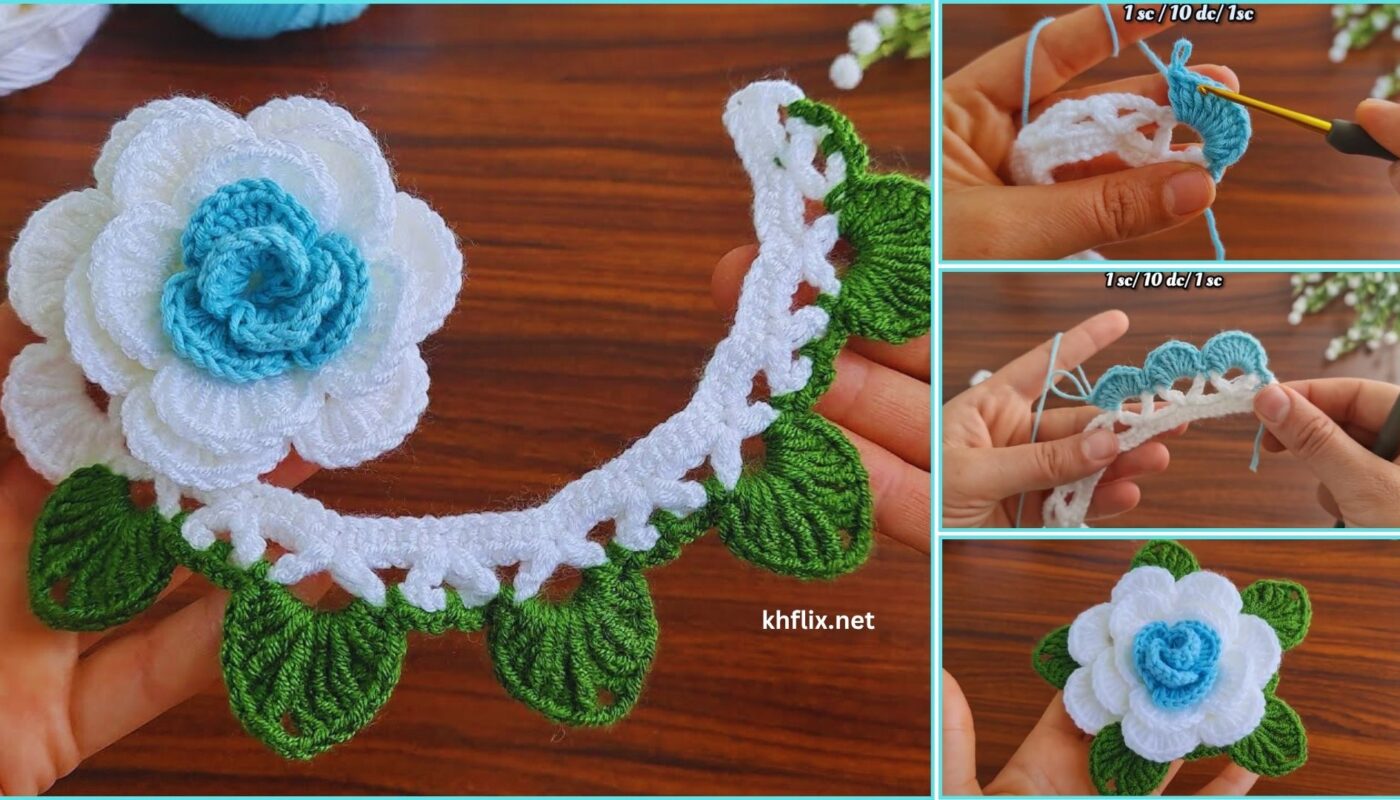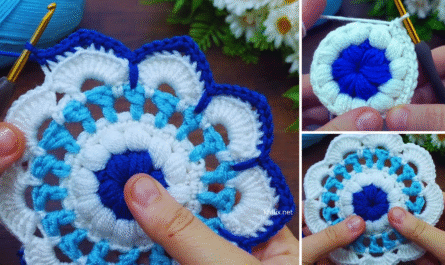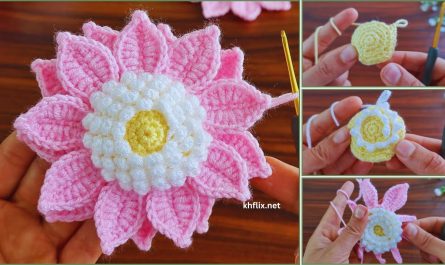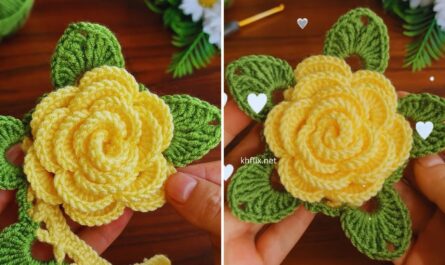Let’s create an absolutely stunning and eye-catching three-color crochet rose flower! This project goes beyond a simple flat appliqué; we’re going to build a truly dimensional, multi-layered bloom that pops with intricate detail and vibrant color transitions. Using three carefully chosen colors will highlight the rose’s natural depth, making it incredibly realistic and beautiful.
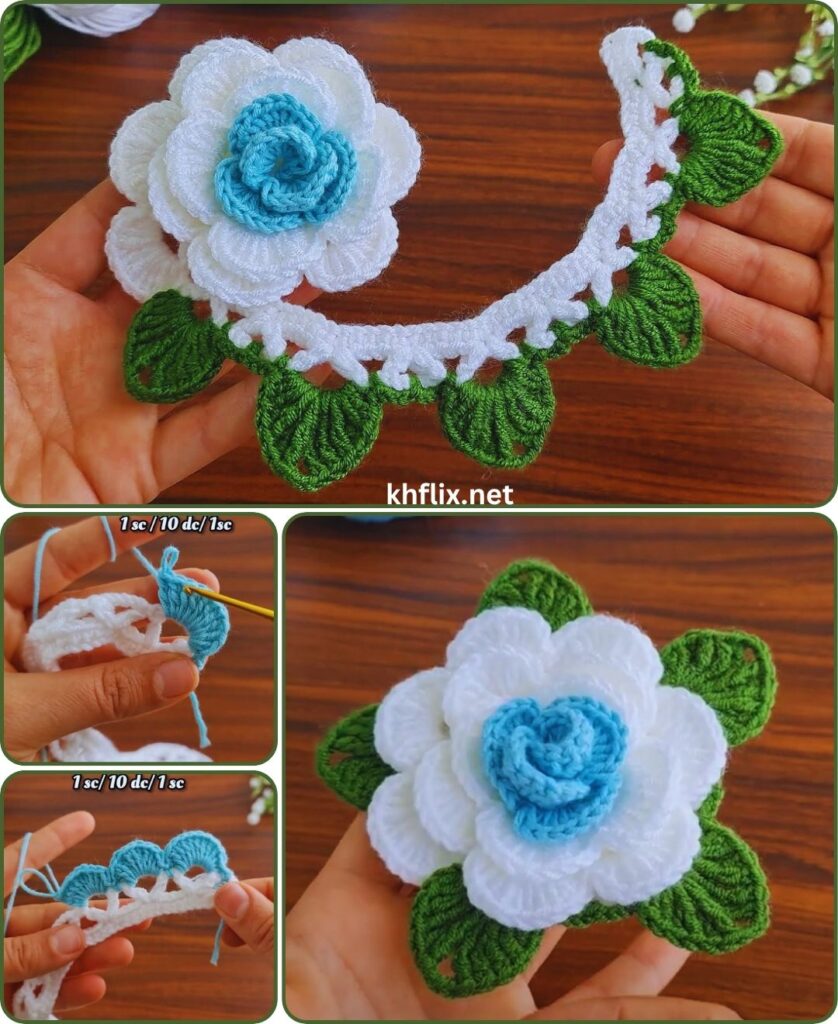
How to Crochet an Eye-Catching Three-Color Rose Flower: Detailed Tutorial
This pattern guides you through making a realistic, dimensional rose by building it up in several layers of petals. We’ll strategically use three colors to emphasize the depths, highlights, and transitions of the flower, giving it a truly professional and artistic finish.
Skill Level: Intermediate
You’ll need to be comfortable with:
- Chain (ch): The basic foundation.
- Slip Stitch (sl st): For joining and neatening.
- Single Crochet (sc): A compact stitch.
- Half Double Crochet (hdc): A medium-height stitch.
- Double Crochet (dc): A taller stitch.
- Treble Crochet (tr): An even taller stitch (sometimes called triple crochet).
- Working in rows: Crocheting back and forth to create strips that will be rolled.
- Color changes: Seamlessly integrating your three chosen yarns.
- Sewing: Using a yarn needle to assemble the rose.
Finished Rose Dimensions (Approximate):
This can vary based on your yarn and hook, but this pattern generally creates a rose about 2.5-3.5 inches (6.5-9 cm) in diameter and 1.5-2 inches (3.8-5 cm) in height. You can adjust the size by using different yarn weights and hook sizes.
Materials You’ll Need:
- Yarn: Approximately 20-35 yards (18-32 meters) total of Worsted Weight (Medium #4) Yarn.
- Color A (Innermost Petals/Core): Choose the lightest or brightest shade for the tightest part of your rose (e.g., pale pink, cream, light yellow).
- Color B (Middle Petals/Transition): Select a shade that harmonizes or subtly contrasts with Color A, and transitions well to Color C (e.g., medium pink, soft peach, a slightly deeper yellow).
- Color C (Outer Petals/Base): Opt for the deepest or most vibrant shade, which will form the largest, most visible petals (e.g., deep red, fuchsia, burgundy, dark rose).
- Yarn Fiber: Acrylic is versatile, comes in many colors, and holds shape well. Cotton provides excellent stitch definition and a slightly stiffer feel, which can be great for holding the flower’s structure. Both are suitable.
- Crochet Hook: Size G/4.0mm or H/5.0mm. A slightly smaller hook can create denser stitches and a firmer flower, which holds its shape better.
- Yarn Needle (Tapestry Needle): Essential for weaving in ends and, most importantly, for sewing the rose together securely.
- Scissors: For cutting yarn.
- Small amount of Green Yarn (Optional): For crocheting a small leaf or two to attach to the base.
Gauge:
Gauge isn’t critical for a flower motif, as it doesn’t need to fit a specific size. However, consistent tension is key to ensuring your petals are uniform and your rose rolls up nicely without buckling or gaping.
Abbreviations Used in This Pattern:
- ch: chain
- sl st: slip stitch
- sc: single crochet
- hdc: half double crochet
- dc: double crochet
- tr: treble crochet (yarn over twice before inserting hook)
- st(s): stitch(es)
- sk: skip
- FO: Fasten Off
- (): repeat instructions within parentheses a specified number of times.
- []: indicates the total number of stitches at the end of a specific row.
The Secret to a Multi-Color Rose: Building in Incremental Strips
Instead of working in traditional rounds for each layer of petals, this rose is made by crocheting a single long strip that’s then carefully rolled and sewn into shape. The key to the three-color effect is changing colors at different sections of this strip. Each color section will naturally form a distinct layer of petals as the strip is rolled, creating a beautiful gradient from the center outwards.
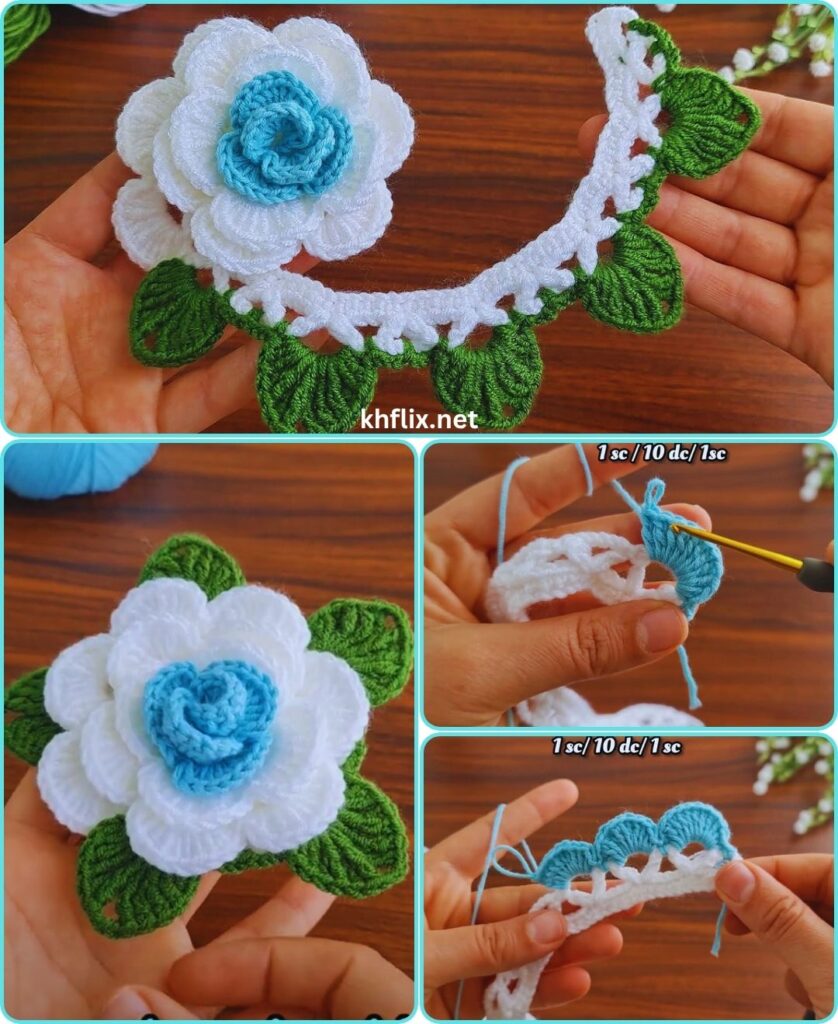
Let’s Crochet Your Beautiful Three-Color Rose!
We’ll crochet a single long strip, incorporating color changes, and then roll it up and sew it to create the rose.
Part 1: Starting the Strip (Color A – Innermost Petals)
This forms the tight core and innermost petals of your rose.
- Start: With Color A, ch 35. (This chain forms the central “spine” of your rose. For a larger rose, chain more stitches; for a smaller one, chain fewer, ensuring the number is divisible by 5 for the petal repeats.)
- Row 1 (Foundation):
- Work 1 hdc into the 3rd ch from hook (the 2 skipped chs count as ch-2 sp).
- Work 1 hdc in each of the next 4 chs.
- Work 1 sc in each of the remaining 28 chs across.
- [35 sts total: 2 skipped chs + 4 hdc + 28 sc]
- Row 2 (First Petal Layer – SC base):
- Ch 1, turn your work.
- Work sc in the first stitch.
- Work sc in each of the next 34 stitches across.
- [35 sc]
- Clean Color Change: On the last sc of this row, stop when you have two loops left on your hook. Drop Color A, pick up Color B, yarn over with Color B, and pull through the remaining two loops to complete the stitch. Now, using Color B, ch 1 and turn.
Part 2: Middle Petal Layer (Color B)
This section creates the next layer of petals, slightly larger than the core.
- Row 3 (Middle Petals):
- With Color B now attached, ch 1, turn.
- *(Sl st in the first stitch. Ch 2, work 3 dc into the next stitch, ch 2, sl st into the next stitch, sl st into the next stitch).*
- Repeat from * to * 5 more times (for a total of 6 petals). You’ll be working these clusters across the next 24 stitches (6 petals x 4 stitches per repeat). This will leave 11 stitches remaining on your strip.
- [6 petals created over 24 stitches]
- Clean Color Change: On the last sl st of this row, stop when you have two loops left on your hook. Drop Color B, pick up Color C, yarn over with Color C, and pull through the remaining two loops to complete the stitch. Now, using Color C, ch 1 and turn.
Part 3: Outer Petal Layer (Color C)
This section forms the largest, most prominent outer petals of your rose.
- Row 4 (Outer Petals):
- With Color C now attached, ch 1, turn.
- *(Sl st in the first stitch. Ch 3, work 1 dc into the next stitch, 2 tr (treble crochet) into the next stitch, 1 dc into the next stitch, ch 3, sl st into the next stitch, sl st into the next stitch).*
- Repeat from * to * 4 more times (for a total of 5 larger petals). You’ll be working these clusters across the next 20 stitches (5 petals x 4 stitches per repeat). This will leave a few stitches at the very end of your strip (from the last 11 stitches remaining in Row 3). These remaining stitches will form the very base of your rose when rolled.
- [5 petals created over 20 stitches]
- Fasten off (FO) Color C, leaving a very long tail (at least 25-30 inches / 63-76 cm) for sewing the rose together.
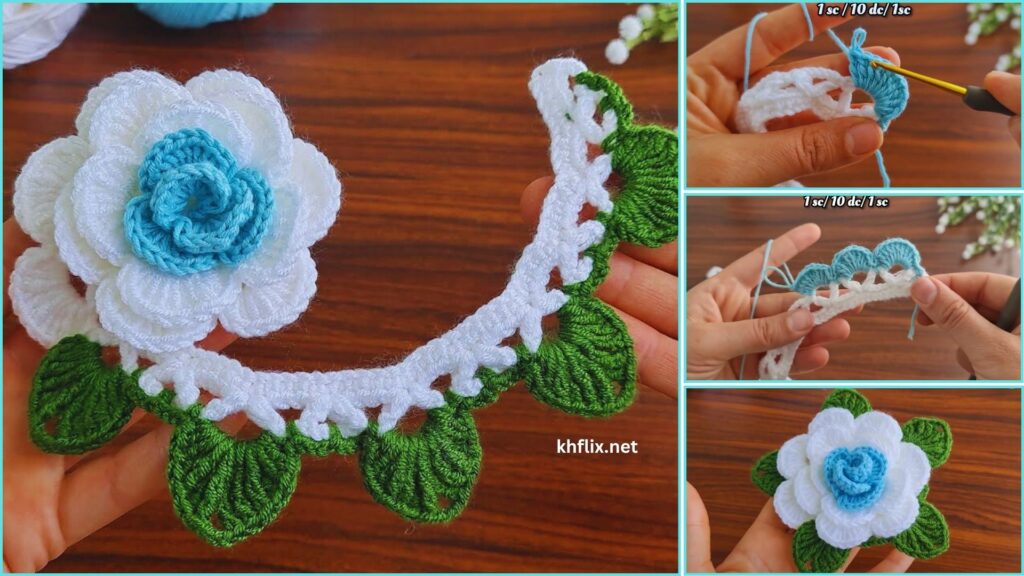
Part 4: Assembling Your Three-Color Rose
This is where your flat strip magically transforms into a beautiful 3D flower!
- Prepare for Rolling: Lay your crocheted strip flat. The “wrong side” (where your starting chain tail is more prominent and the backs of stitches are visible) should be facing up. The section with the hdc/sc stitches (from Color A, Rows 1 & 2) should be at the top, and the larger tr-petal section (from Color C, Row 4) at the bottom.
- Start Rolling the Center (Color A):
- Take the very beginning of the strip (the end with the Color A hdc stitches).
- Tightly roll this end inward, creating the very center bud of your rose. Roll it snugly for about 1-1.5 inches (2.5-3.8 cm) or until you feel the core looks right. The Color A section should form a tight spiral.
- Hold the rolled center firmly at the base with one hand.
- Continue Rolling the Middle Petals (Color B):
- As you continue to roll the strip, slightly loosen your tension. Allow the petals from Color B to naturally flare out a bit as they wrap around the Color A center. These will form the second, distinct layer of petals.
- Continue Rolling the Outer Petals (Color C):
- Finally, the largest petals from Color C will wrap around, creating the outermost layer. These should naturally cup and open up around the inner layers, giving the rose its full, blooming appearance.
- Keep rolling until you reach the very end of your strip.
- Secure with Sewing:
- Once you’ve rolled the entire strip into your desired rose shape, hold the base firmly with one hand.
- Thread your yarn needle with the long tail from Color C that you left at the end of Row 4.
- Begin to stitch through all layers of the rose’s base, from one side to the other, to securely fasten it. Make several strong stitches, going through the center of the base and out the other side. Think of it like tacking all the coiled layers together.
- Periodically check the front of your rose to ensure your stitches aren’t too visible and that the petals are holding their desired shape.
- Work your way around the entire base of the rose, securing all the layers down. You want the base to be flat and stable, preventing the rose from unraveling.
- Make sure to pull your stitches snug but not so tight that they distort the top of the rose.
Part 5: Finishing Touches (Optional Leaf & Final Weaving)
- Weave in All Remaining Ends:
- This is crucial for a clean, professional finish. You’ll have tails from your starting chain and each color change point.
- Thread each yarn tail onto your yarn needle.
- Carefully weave them into the stitches on the back side of your rose. For the color change tails, weave them into the stitches of the same color they originated from.
- Take your time to ensure all tails are securely hidden within the fabric.
- Crochet a Leaf (Optional):
- With green yarn, ch 8.
- Sl st in 2nd ch from hook, sc in next ch, hdc in next ch, dc in next ch, hdc in next ch, sc in next ch, sl st in last ch.
- Ch 2, then work on the other side of the initial chain: sl st in next ch (base of first sl st), sc in next ch, hdc in next ch, dc in next ch, hdc in next ch, sc in next ch, sl st in last ch.
- FO, leaving a long tail. Use this tail to sew the leaf securely to the back base of your rose.
- Shape Your Rose:
- Gently use your fingers to fluff out the petals. The inner petals should remain relatively tight, while the outer ones should open up more. Adjust them until your rose looks natural, full, and utterly beautiful.
- A light steam block can help the petals settle and hold their shape more permanently. Hover a steamer or an iron (on a low, steam setting) over the flower without touching the fabric. Then, gently shape the petals with your hands while the yarn is warm and pliable. Allow it to air dry completely. Be careful not to flatten the 3D petals too much if you want them to remain prominent.
You’ve now created a truly gorgeous and eye-catching three-color crochet rose flower! These dimensional beauties are perfect for embellishing scarves, hats, bags, headbands, or even as decorative accents on gift wrapping. What stunning color trios are you excited to try for your next blooming creation?

